If you want high dividends right now (and who doesn’t?), but you don’t want to overpay, there’s one place you need to look: utilities.
There are three ways to tap into this sector, but only one hands you the most upside and fattest dividend yields from these unloved cash-spinning companies:
- Buy utility stocks individually
- Buy ETFs specializing in utilities
- Buy closed-end funds (CEFs) specializing in utilities
The third option is the best one. To understand why, we need to go back a few months.
Back on March 1, I recommended Reaves Utility Income (UTG), a utility CEF that yields 6.9% (spoiler: those big yields are common with CEFs and are a big reason why these funds are an awesome bet for income investors).
Here’s what happened to UTG since my March article:
UTG Powers Up
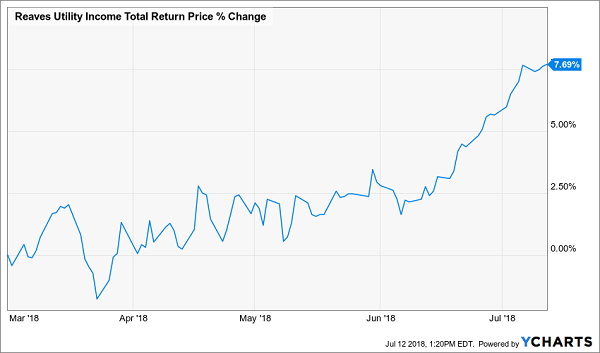
A 7.7% return in four and a half months is impressive for any asset class, but for a “widow and orphan” sector like utilities, it’s unheard of.
So what powered this nice return?
Let’s rewind to early 2018. Energy prices were rising, oil was finally out of its slump and investors were getting nervous about volatility, a trade war and political instability.
Utility investors, being more risk-averse than those who focus on most other sectors, sold off:
Utilities Flicker Out
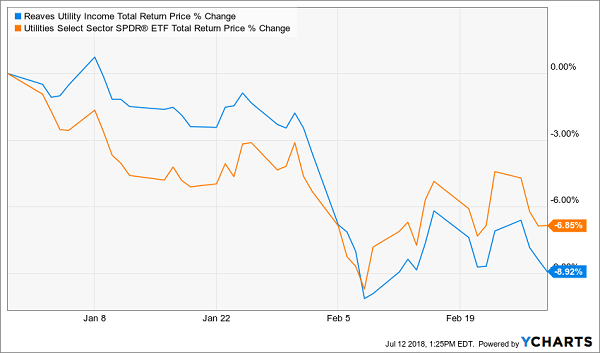
However, a look at the data made one conclusion unavoidable: utilities’ cash flow was strong, an improving economy meant more energy demand (and thus more income for utilities) and several utilities were far undervalued relative to their book values (or what their assets would fetch if these companies were broken up and sold off).
If you saw this data and ignored the noise from the financial press, you knew there was only one thing to do: buy.
The good news is that it’s not too late for utilities: the sector is only up 1.3% year to date versus the S&P 500’s 5.5%, and because utilities’ earnings are up about 15% from a year ago, this sector is one of the most undervalued in the S&P 500.
Plus, it’s one of the highest yielding, with the benchmark Utilities Select Sector SPDR ETF (XLU) paying 3.4% dividends, or nearly double the yield on your average S&P 500 stock.
But as I mentioned, UTG yields 6.9%, or twice what XLU pays—which brings me to my No. 1 reason for choosing utility CEFs over ETFs.
CEFs vs. ETFs: A Bigger Income Stream
The first reason to choose CEFs is the most gratifying: the income.
As I mentioned, UTG yields a nice 6.8%, but there are some CEFs yielding even more out there, as you can see from the following chart, which also shows each fund’s discount to net asset value (NAV, or the difference between each fund’s market price and the value of its portfolio), yield on price and long-term compound annual growth rate (CAGR):
Utility CEFs With Massive Dividend Payouts
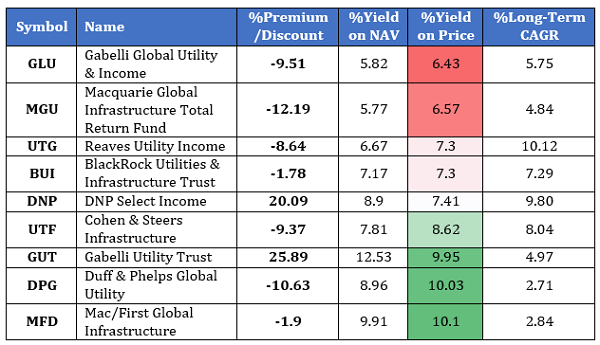
Why settle for less than 4% income when you can get 10%?
You might want to answer that the ETFs surely outperform the CEFs, but you’d be wrong—which brings me to reason No. 2 for going with high-yield CEFs over their “dumb” ETF counterparts…
CEFs vs. ETFs, Round 2: Market Outperformance
Think actively managed CEFs must underperform passive ETFs? Think again.
While some utility funds have underperformed XLU over the long term, others have not. Here’s how the index stacks up, with the outperformers marked in green and the underperformers in red.
Popular ETF Gets Dusted

As you can see, UTG, along with three of its peers, has done better than XLU—and not by a little, either. If you had invested $100,000 in UTG a decade ago, you would now have over $260,000, while that same investment in XLU would be worth a hair shy of $191,000.
But how can you spot the winners and avoid the losers? It’s all about the discount to NAV.
CEFs vs. ETFs, Round 3: The Discount Tells the Tale
Most people love CEFs for their large income streams, but the best way to win with these funds is to buy when the discount is huge. Since CEFs’ market prices regularly vary from their NAVs, buying funds when they are at unusually wide discounts and selling when their discounts switch to premiums is a surefire way to make a lot of money fast.
That was why I recommended UTG over the index back in March. Its discount to NAV had sunk to 8.2% after trading at a premium in 2017.
Snapshot of a Buying Opportunity
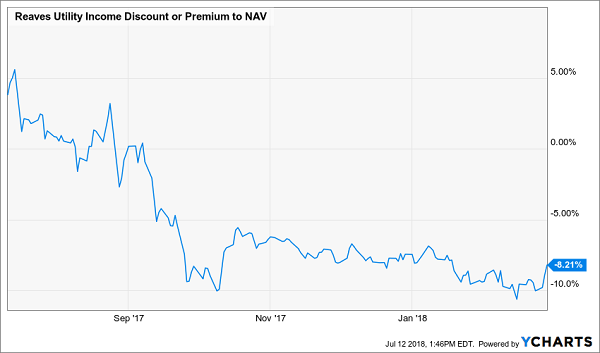
And here’s the good news: UTG’s discount is still where it was when I recommended it, because its NAV has soared in recent weeks, but the market is still pessimistic on utilities:
UTG Still on Sale
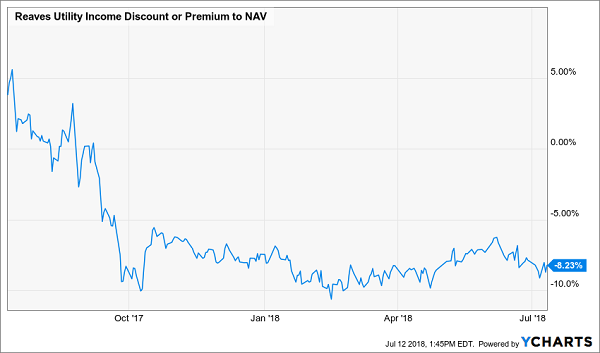
This means that despite the fund’s 7.7% gains since March, the market is still underpricing it. Hard to believe, but true. This is why you should consider jumping into this fund before the sale ends.
And make no mistake: as soon as the market remembers utilities’ great ability to generate cash (and it will), this sale will end … and fast.
— Michael Foster
My No. 1 CEF Buy Now: 810% Gains and 8.4% Dividends in 1 Click! [sponsor]
My favorite CEF to buy right now is the perfect example. This stout fund has crushed the market since inception, with a monstrous 810% return!
1 Chart That Demolishes Conventional “Wisdom”
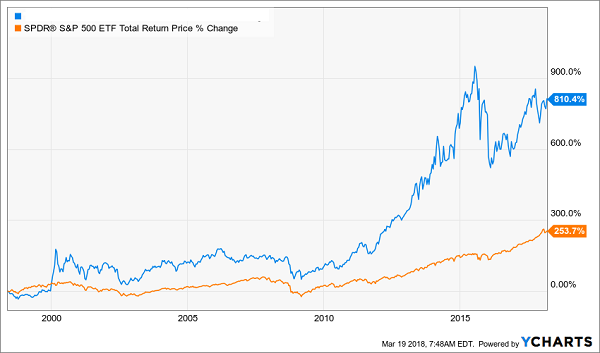
This is incredible—the kind of gain you might expect from, say, a small-cap tech stock, not a conservative fund like this one.
To give you a little more context, my No. 1 pick is a pharma fund run by some of the smartest minds in the business—researchers and doctors with “boots on the ground” experience zeroing in on the next billion-dollar-plus blockbuster drug.
That alone is reason enough to put this one on your short list.
There’s more, though. Because this dynamic fund also throws off an incredible 8.4% dividend, too!
You’d think a gain and a payout like that would at least get a few folks in the mainstream media talking.
No way. Not yet, anyway.
Why? For one, this low-key CEF is tiny, with just a $391-million market cap, so it gets even less attention than you typical CEF does.
Yet as I write, this fund trades at a 4% discount to NAV. That may not sound like much, but it’s traded at fat premiums MANY times in the past 5 years.
When it does so again, we’ll be locked in for fast 20%+ upside from here, on top of that massive dividend!
That’s our cue to buy—and I’ll give you full details on this fund (I’m talking name, ticker symbol, buy-under price and more), plus the whole story on my 4 other top CEF picks when you CLICK HERE now.
By the way, I’ve hand-picked these 5 CEFs to flourish as interest rates rise. AND your average yield (8.1% on all 5 funds) will soar as their dividend payouts skyrocket, too. Don’t miss this incredible income (and growth) opportunity. CLICK HERE for full details on these 5 rock-solid cash machines now.
Source: Contrarian Outlook

